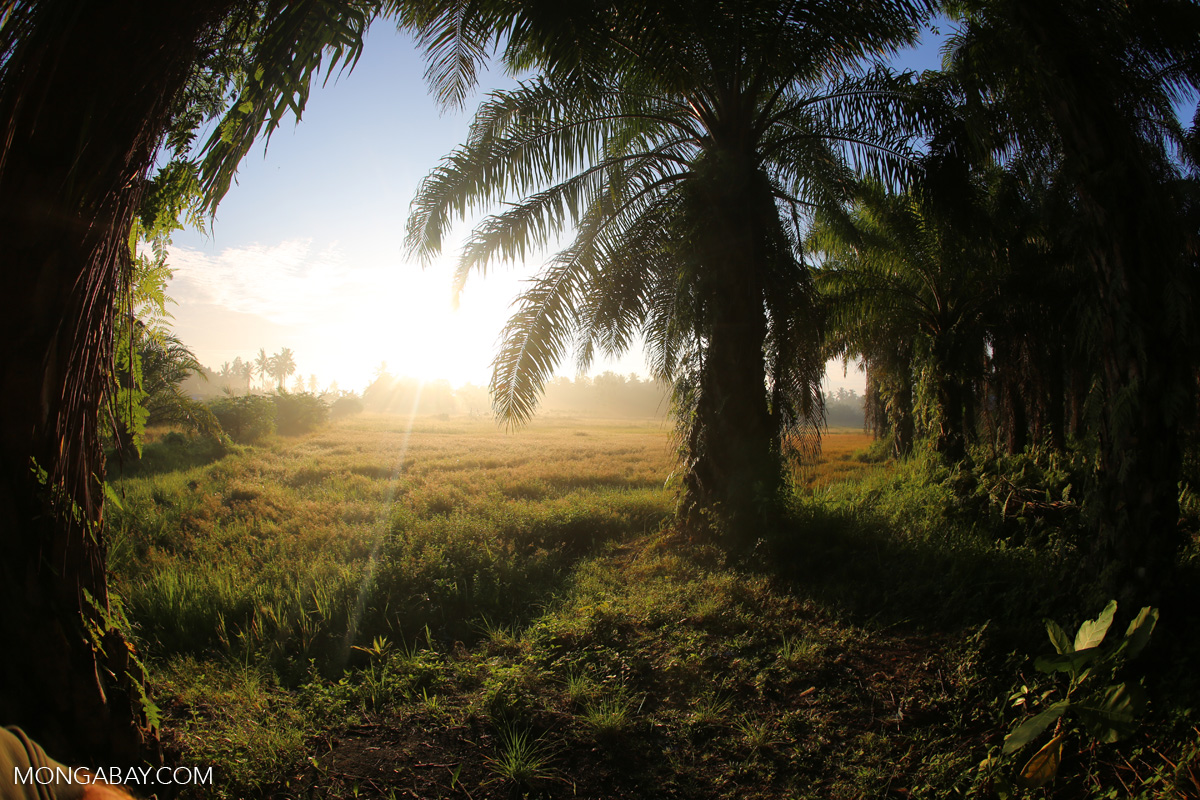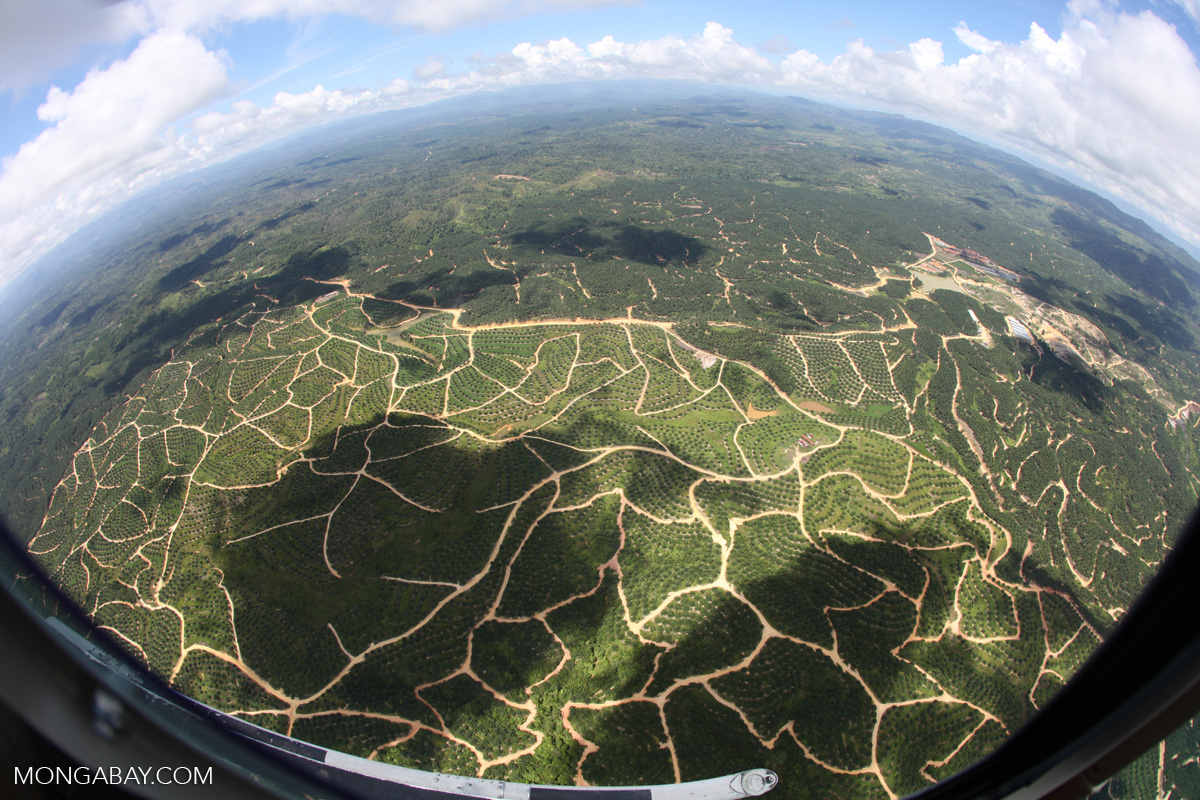- Banks are starting to come up with ways to encourage sustainability in the palm oil sector, whose unbridled expansion is fueling deforestation and rights abuses across the world.
- Still, the nascent green finance industry faces a number of obstacles as it seeks to expand its influence.
- These include a lack of transparency with regard to company ownership, misguided valuations of palm oil enterprises, and more.
Part five in a five-part series on the attitudes of palm oil financiers towards company sustainability. Read the first, second, third and fourth installments.
Banks and investors are increasingly looking for ways to hold companies accountable for their actions. Previous articles in this series looked at how financiers might deny capital to palm oil companies with poor environmental performance. On the other side of the coin, some leading banks are exploring a more positive approach, by introducing incentives that encourage firms to perform better.
Among the commercial banks with environmental, social and governance (ESG) policies – these entail screening companies for unsustainable practices – a significant number also have standalone policies on financing palm oil. Many require their clients in the sector to either be members of the Roundtable on Sustainable Palm Oil (RSPO) or have a timebound plan to achieve this.[142] At present, banks are moving toward a more collaborative model: working with clients to identify gaps, and providing the necessary financing for them to fully adopt sustainable palm oil.
One of the most important agreements in this direction is the Soft Commodities Compact, developed as a collaboration between the Banking Environment Initiative (BEI) and the Consumer Goods Forum (CGF). Signatory banks to the compact agree to use “appropriate financing mechanisms” to help non-RSPO certified clients achieve certification, such that by 2020, all their corporate and investment banking clients in the palm oil sector will be RSPO-certified.[143] The compact’s signatories are Barclays, BNP Paribas, Deutsche Bank, Lloyds, Rabobank, RBS, Santander, Standard Chartered, UBS, and Westpac.[144]
A few banks have also begun extending preferential credit to “good actors” in the palm oil sector. In 2014, HSBC launched a discounted finance product for clients trading RSPO-certified “sustainable” palm oil internationally.[145] Another such bank is Rabobank, which gives clients that are “leaders in sustainability” “priority when providing finance,” “[doubling] the amount of services provided to these customers.”[146] Rabobank also has its Sustainable Agriculture Guarantee Fund, which “[enhances] access…to working capital credit” for “small- and medium-sized producers of sustainable agricultural products in developing countries.”[147]

Another milestone came in January 2014, with the introduction of the Sustainable Shipment Letter of Credit by the BEI.[148] Under this agreement, the International Finance Corporation, the World Bank’s investment arm, will offer preferential terms of credit to its partner banks when they finance the import of RSPO-certified palm oil to emerging markets.[149] Uptake has been promising, with one bank reporting nearly $50 million of new “sustainable shipment” business from July to December 2014. A similar approach is now being explored for the shipment of other commodities.[150]
A few banks have even gone as far as to integrate “green-ness” as an integral part of their corporate agenda. One of these is South Africa’s Nedbank, which launched South Africa’s first ESG-benchmarked index, the Nedbank Index, in 2011.[151] Other Nedbank initiatives include a dedicated Carbon Finance Team, which develops strategies for clients to reduce their carbon footprints,[152] and a Green Affinity Banking program, which donates money to environmental causes on behalf of clients at no additional cost.[153]
One condition is crucial for green financing schemes to succeed: all commercial banks within a region must adopt the same message. For instance, offering preferential rates to “good” actors is unlikely to have an impact if other banks decide to offer even lower rates, with fewer restrictions.[154] Cooperation is also a key consideration for the consortiums of banks that underwrite major loans and IPOs. “When a consortium finances a group, one bank isn’t going to give incentives when the others don’t,” noted Eric Wakker, of sustainability consultancy Aidenvironment.[155]
The way forward
Despite large leaps forward in the past few years, the green finance industry is still in its infancy. Though an increasing number of financiers are recognizing the importance of sustainable finance and implementing stricter ESG standards, “institutions are still learning to make short- and long-term buy and sell decisions that actively incorporate environmental risks and opportunities,” said Gabriel Thoumi, sustainability analyst and faculty at the University of Maryland’s Robert H. Smith School of Business.[156]
However, time is of the essence. Unsustainable forest commodity farming is causing forests to be lost at an alarming rate, and with it, irreplaceable biodiversity and the livelihoods of countless indigenous communities. From a financial perspective, the inability of agribusiness companies to internalize environmental costs is a massive economic problem. Early estimates indicate that when healthcare, logistical and firefighting costs are considered, this year’s fire and haze disaster may have cost Indonesia $47 billion.[157]

The following factors will be crucial in accelerating the transition of palm oil financing toward full environmental sustainability:
1. Greater transparency with regard to company ownership and environmental footprint
At present, none of the major business information agencies provide comprehensive data on company ownership. A number of services do exist to help listed companies understand their own ownership, including NASDAQ and the corporate access teams within major banks.[158] Both services are key for investors to make sure they do not contribute, directly or indirectly, to financing unsustainable palm oil.
ESG materiality assessments for companies are not mandatory in the vast majority of jurisdictions. Without these assessments, critical ESG issues will not be discussed in financial statements, and will not be brought to the attention of financial analysts. There should be a shift in regulations so that ESG assessments are no longer considered optional, but a part of standard reporting and disclosure procedures.[159]
2. Greater collaboration between environmentally minded financiers
Many of the issues in sustainable finance are too big for any institution to tackle alone. Corporate banks need to work together to present a cohesive stance to the palm oil industry, and avoid being undercut by competitors less concerned with sustainability. There is also great potential for leading funds, such as the Norwegian and Swedish pension funds, to spearhead large-scale conservation finance projects; the California Public Employees’ Retirement System is one example of a major fund that is leading interinstitutional efforts to promote regulation and legislation.[160]

3. Enforcement of corporate pledges to purge their supply chains of deforestation, peatlands conversion and rights abuses
In the absence of stronger regulations by the Indonesian government, the “No Deforestation, No Peat, No Exploitation” pledges made by major palm oil traders and consumer goods manufacturers remain the most material risk to unsustainable palm oil producers. Enforcing these pledges would cut unsustainable companies out of major segments of the market. It would also negatively impact measures of risk used by financial analysts, making these companies less attractive prospects for investors and financiers.[161]
4. Incorporating the tools that already exist to measure the environmental impact of portfolios
A few tools have been developed to help portfolio managers measure the strength of their environmental policies and their exposure to environmental risk. One such example is the National Capital Declaration’s Soft Commodity Forest Risk Tool. However, these tools are not being used by enough portfolio managers, simply because they are not being asked to employ it. “If we want consumer goods companies to have zero-deforestation commitments, should asset managers not make the same commitment?” Thoumi asked. “The same portfolio managers who work on advocacy need to themselves incorporate these tools.”[162]
5. Defining the value of palm oil companies in terms of yield, not size of land banks
If the yield of all existing oil palm plantations were improved by 2% each year, the increase in output would be enough to meet 100% of the projected growth in global demand.[163] Yet, many investors continue to measure the potential of oil palm companies in terms of the size of their land banks, which is easier to quantify, creating an incentive to clear land rather than adopt better farming methods. Measuring earnings potential in terms of productivity would direct more capital toward more sustainable companies, which would also generate more value in the long run.

6. A cultural shift for many in the financial industry
Though many financiers have recognized the importance of implementing ESG standards, the industry as a whole is still restricted by systemic structures that favor short-term profit over long-term environmental performance. To overcome this, metrics measuring environmental performance need to be built into the compensation structures of analysts and fund managers.
In addition, Thoumi said, sustainability should be treated as an integral component of financial considerations rather than a separate concern, by utilizing frameworks such as Vanguard’s RRTTLLU (Return, Risk, Time, Tax, Liquidity, Legal, Unique) tool.[164] “When individuals employed to develop and implement sustainable investing strategies are considered as profit centers and incorporated into normal client money management structures – rather than as cost centers and removed from their analyst and portfolio manager colleagues – that will be the sea change the industry needs.”[165]
Citations:
[142] Various banks; for example, see Citi’s “Environmental Policy Framework,” 2012 (http://www.rspo.org/file/acop/citi/F-Lending-Policy.pdf) and UBS’s “Environmental and Social Risk Policy Framework,” 2015 (http://www.ubs.com/content/dam/ubs/global/about_ubs/corporate_responsibility/UBS-ESR-framework.pdf).
[143] ‘Soft Commodities’ Compact, Banking Environment Initiative, 2014, accessed November 22 2015. http://www.cisl.cam.ac.uk/business-action/sustainable-finance/banking-environment-initiative/pdfs/the-bei-and-cgfs-soft-commodities-compact.pdf
[144] Cambridge Institute for Sustainability Leadership, “The Banking Environment Initiative (BEI) and Consumer Goods Forum (CGF)’s ‘Soft Commodities’ Compact,” accessed November 22 2015. http://www.cisl.cam.ac.uk/business-action/sustainable-finance/banking-environment-initiative/programme/soft-commodities
[145] HSBC, “Forestry and Agricultural Commodities,” accessed November 22 2015. http://www.hsbc.com/citizenship/sustainability/finance/forestry-and-agricultural-commodities
[146] Annual Report 2014, Rabobank Group, p29. https://www.rabobank.com/en/images/annual-report-2014-rabobank-group.pdf
[147] Rabobank International, “Rabo Sustainable Agriculture Guarantee Fund,” p4. https://www.agriskmanagementforum.org/sites/agriskmanagementforum.org/files/Documents/Rabo%20Brochure.pdf
[148] The BEI’s Sustainable Shipment LC: A Financing Innovation to Incentivise Sustainability Commodity Trade, University of Cambridge Programme for Sustainable Leadership, 2014. http://www.cisl.cam.ac.uk/publications/publication-pdfs/the-banking-environment-initiative-sustainable-shi.pdf
[149] International Finance Corporation, “Sustainable Shipment LCs,” accessed November 22 2015. http://www.ifc.org/wps/wcm/connect/industry_ext_content/ifc_external_corporate_site/industries/financial+markets/trade+and+supply+chain/gtfp/gfm-tsc-gtfp-sustainablelc
[150] Andrew Voysey, “Can Changing How World Trade Is Financed Actually Change the World?,” Consumer Goods Forum, June 9 2015. http://www.theconsumergoodsforum.com/blog/406-can-changing-how-world-trade-is-financed-actually-change-the-world
[151] Dennis Ndaba, “South Africa’s First Green Index Launched,” Engineering News, August 12 2011. http://www.engineeringnews.co.za/article/nedbank-capital-launches-south-africas-first-green-index-2011-08-12
[152] Nedbank Capital, “Carbon Finance,” accessed November 22 2015. http://www.capital.nedbank.co.za/capital/carbon-finance
[153] Nedbank, “Green Affinities,” accessed November 22 2015. https://www.nedbank.co.za/website/content/GreenAffinities/
[154] Iain Henderson (personal communication, October 29 2015).
[155] Eric Wakker (personal communication, November 7 2015).
[156] Gabriel Thoumi (personal communication, October 20 2015).
[157] Francis Chan, “$47b? Indonesia Counts Costs of Haze,” The Straits Times, October 11 2015. http://www.straitstimes.com/asia/47b-indonesia-counts-costs-of-haze
[158] Cary Krosinsky (personal communication, July 30, 2015).
[159] Ben Caldecott and Jeremy McDaniels, “Financial Dynamics of the Environment,” p28.
[160] Ibid., pp. 41-42.
[161] Indonesian Palm Oil Growers’ Exposure to Sustainability Purchasing Policies, Chain Reaction Research, June 30 2015. https://chainreactionresearch.files.wordpress.com/2015/07/2015-06-30-idx-companies-report.pdf
[162] Gabriel Thoumi (personal communication, December 7 2015).
[163] Fitrian Ardiansyah, “Climate Change, Deforestation and the Role of Sustainable Palm Oil,” WWF Indonesia, p6. http://www.academia.edu/1086768/Climate_Change_Deforestation_and_the_Role_of_Sustainable_Palm_Oil
[164] Categorise and Evaluate Data: The RRTTLLU Framework, Vanguard, 2011. https://www.vanguard.co.uk/documents/adv/literature/advice_process/categorise-and-evaluate-data.pdf
[165] Gabriel Thoumi (personal communication, December 7 2015).